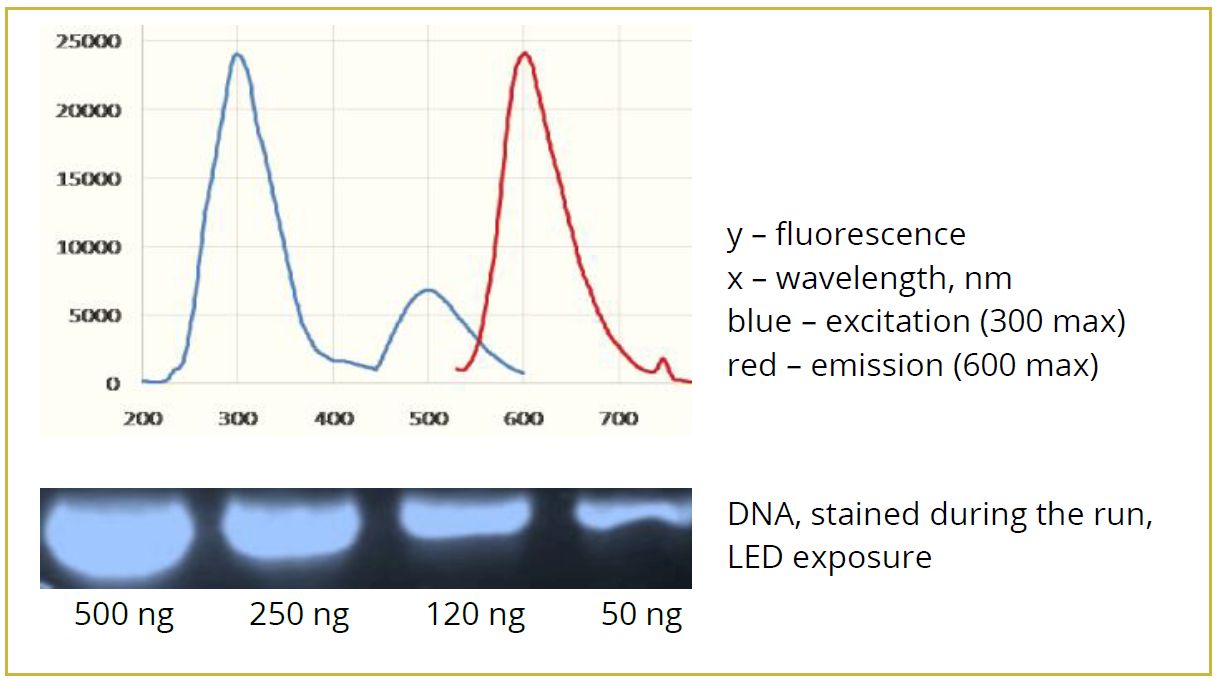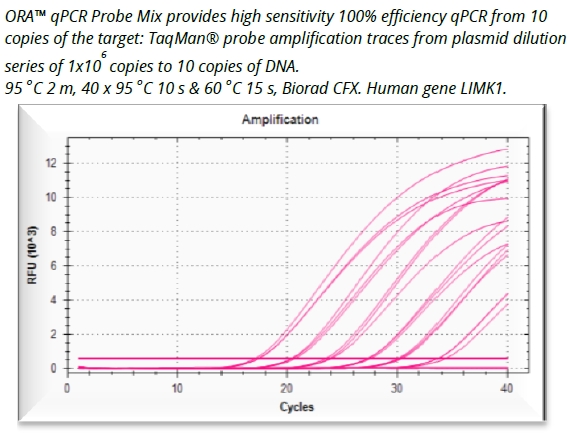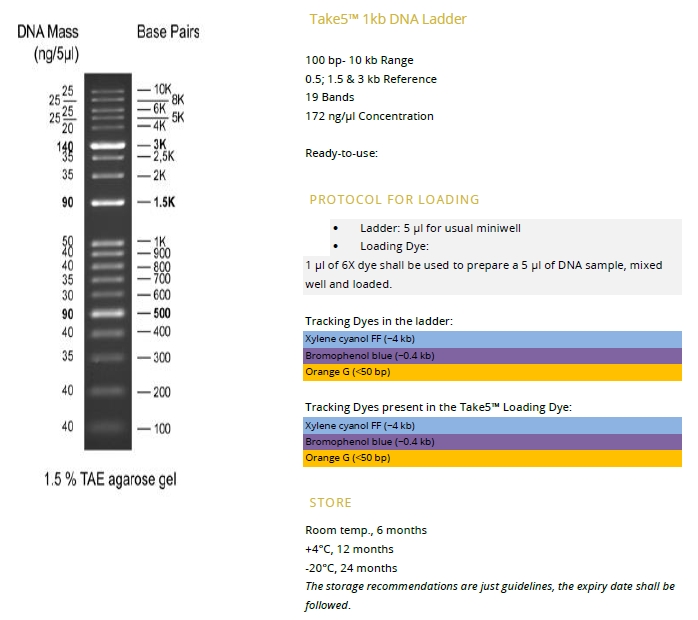ORA™ SEE qPCR Probe Mix
Applications
- qPCR assays based on specific probes such as TaqMan®, Molecular Beacons, Scorpions™ Probes.
- Gene expression analysis, quantification of gDNA, cDNA, viral DNA, low copy number genes.
Benefits
- Universal - both standard and fast cycling, all probe qPCR assays.
- qPCR of GC or AT rich templates, single-plex & multiplexing.
- Rapid extension, early Ct.
- Inert blue dye for a better sample visibility and tracking.
ORA™ SEE qPCR Probe Mix
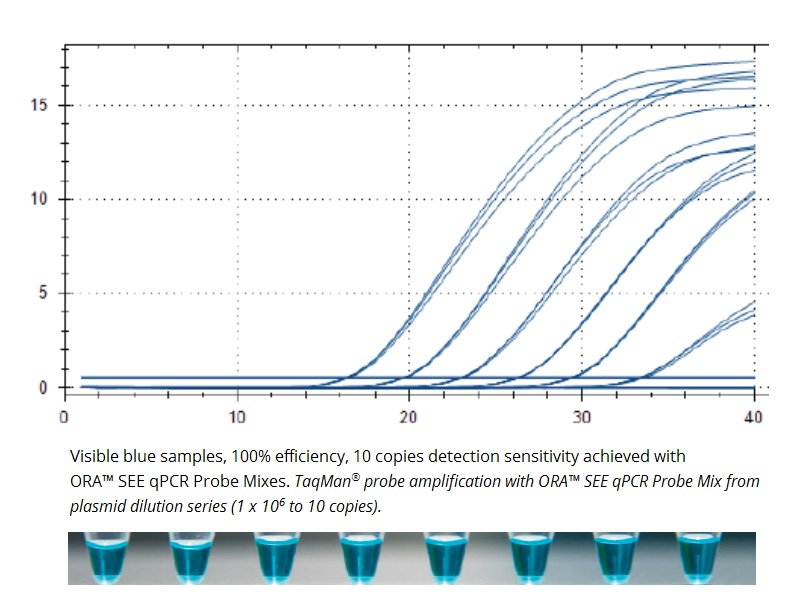
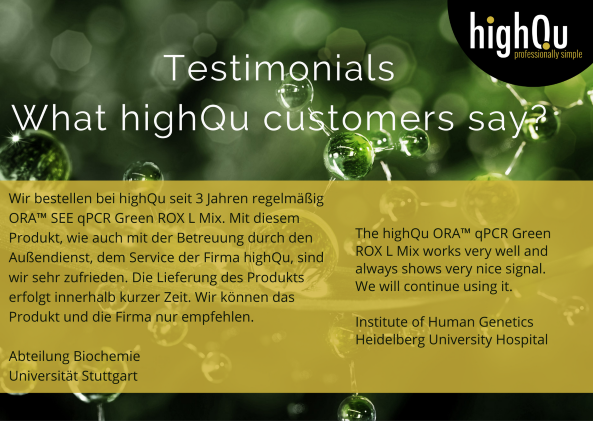






- Description highQu qPCR master mixes are based on the small molecular inhibitor technology Hot Start PCR allowing to achieve highest sen… More
- Protocols Download Protocol and Specifications - Product Insert ORA™ SEE qPCR Probe Mix, 2X Ask for a Sample today Have technical ques More
- Specifications Download Protocol and Specifications - Product Insert ORA™ SEE qPCR Probe Mix, 2X Download MSDS ORA™ SEE qPCR Probe Mix, 2X More
- Resources Download Protocol and Specifications - Product Insert ORA™ SEE qPCR Probe Mix, 2X Download MSDS ORA™ SEE qPCR Probe Mix, 2X More
Product information "ORA™ SEE qPCR Probe Mix"
highQu qPCR master mixes are based on the small molecular inhibitor technology Hot Start PCR allowing to achieve highest sensitivity and specificity under both standard and fast qPCR cycling conditions. They provide excellent results on both AT and GC rich templates, in multiplexing and guaranty rapid extension with early Ct values with minimum or no optimization.
ORA™ SEE qPCR mixes provide an additional advantage of a simplified tracking of the process, as they are colored with an inert blue dye to make samples much better visible during pipetting and handling.
Our master mixes are supplied with PCR Water to guaranty the best performance. To suit the broad instrument range the ORA™ qPCR Probe Master mixes are available in three versions – without ROX, with low or high ROX concentration.
- Download Protocol and Specifications - Product Insert ORA™ SEE qPCR Probe Mix, 2X
- Ask for a Sample today
- Have technical questions? Contact us
- Download a list of Publications mentioning highQu products
- Or see how others use our products at bioz.com or google scholar
- Download Protocol and Specifications - Product Insert ORA™ SEE qPCR Probe Mix, 2X
- Download MSDS ORA™ SEE qPCR Probe Mix, 2X
- Need a lot-specific Certificate of Analysis? E-mail us at info@highQu.com
- Want custom formulations or bulk sizes? E-mail us at info@highQu.com, and check our OEM offers
- Have more specific questions? Contact us
- Download Protocol and Specifications - Product Insert ORA™ SEE qPCR Probe Mix, 2X
- Download MSDS ORA™ SEE qPCR Probe Mix, 2X
- Download highQu Catalogue of Premium Research Tools
- Download a list of Publications mentioning highQu products
- Or see how others use our products at bioz.com or google scholar
- Download Product Pricelist (DE 2021)
- Download all highQu Product Inserts and MSDS sheets
- Have questions? Contact us
Related Products
StainIN™ eco-RED Nucleic Acid Stain
€98.00*
StainIN™ eco-RED Nucleic Acid Stain, a 10000X concentrated aqueous solution is a significantly safer alternative to ethidium bromide. It is same easy to use, twice as sensitive and much more secure. At least twice as economical as competing products, this novel DMSO-free stain can be also used and disposed with less environmental and health concerns compared to ethidium bromide. StainIN™ eco-RED is a fluorescent dye that allows detection of >0,1 ng of DNA in both agarose and polyacrylamide gels. It binds to both ds DNA, ssDNA and RNA and emits red fluorescence detectable under the LED or UV light and documented with same filters as ethidium bromide. For cloning applications, LED light is recommended. The lower than ethidium bromide carcinogenicity of the dye has been proven by Ames-test.
The carcinogenicity and a high toxicity of a widely used gel stain Ethidium Bromide (EtBr) is one of the biggest safety and environmental problems in the labs where gel electrophoresis is a daily routine. Therefore, there is a need for a safer ethidium bromide alternatives to be used in laboratories. The novel less toxic nucleic acid dyes used for agarose gel electrophoresis address this ethidium bromide problem and minimize environmental concerns.
highQu StainIN™ eco-RED Nucleic Acid Stain provides a significantly safer alternative to ethidium bromide while delivering up to several times higher detection sensitivity. Same like ethidium bromide, the stain is used during the process of electrophoresis in an agarose gel or PAAG and (optionally) in the electrophoresis running buffer, or alternatively, for a post-run staining of the gels in a tray with the buffer.
Despite having a proven lower mutagenicity, all nucleic acid stains shall be handled with care, as they interact with DNA and RNA. Used electrophoresis buffer with a stain as well as melted gels shall be run through approved (carbon) filters. If the absence of residual fluorescence is confirmed, the liquids can be disposed with plenty of water down the drain.
Alternatively, all used liquids can be autoclaved or heated as the StainIN™ eco-RED Nucleic Acid Stain degrades during the long exposure to above 100ºC temperature.
The safety office shall be consulted periodically to match local regulations, as these regulations vary and change. Despite of tests described in this report, the seller of the listed stains and other reagents does not take any responsibility for the possible damage resulting from handling any sold chemical or reagent.
Frequently asked questions about the new Nucleic Acids Stain
1. What are the advantages of the new StainIN™ eco-RED NA Stain over the old version StainIN™ RED?
The new stain is purely aqueous solution. The old StainIN™ RED had DMSO as solvent.
The new stain is room temperature stable, shipped at ambient temperature. Store it at your electrophoresis bench. The old StainIN™ RED was stored at +4°C.
StainIN™ eco-RED NA Stain is more flexible – detectable under both UV and LED light.
More convenient protocol – the stain can be used both during the gel run and as a post-run staining.
Same or better sensitivity compared to the old stain.
2. Is the color of the solution the same as before?
The new stain is a darker shade of red.
3. What is the concentration of the StainIN™ eco-RED Nucleic Acids Stain?
It is 10,000X concentrated, however the number of applications for post run staining is difficult to calculate because multiple gels can be stained in the same staining solution.
4. What is the solvent used in the StainIN™ eco-RED Nucleic Acids Stain?
The solvent is 100% water.
5. Which stains are similar to StainIN™ eco-RED Nucleic Acids Stain?
The closest similar stains are Ethidium Bromide and GelRed (Biotium).
6. What is the sensitivity of the StainIN™ eco-RED Nucleic Acids Stain in ng/band?
The sensitivity ranges from 0.1 to 0.3 ng DNA/band or even higher, depending on factors such as the staining method used, imaging capability, detection, and gel thickness.
7. What is the emission wavelength of the StainIN™ eco-RED Nucleic Acids Stain?
The emission wavelength is 600 nm.
8. What is the excitation wavelength of the StainIN™ eco-RED Nucleic Acids Stain?
The excitation wavelength is 300 nm.
9. Can StainIN™ eco-RED Nucleic Acids Stain be used for in-gel and in-buffer staining?
Yes, it can be used for both in-gel and in-buffer staining post electrophoresis run.
10. How should the stain be used during a gel run in agarose gels?
Use 8-10 µl of the stain in 100 ml agarose gel solution cooled down for pouring, nothing to be added in to the electrophoresis buffer.
11. How to use StainIN™ eco-RED Nucleic Acids Stain with PAAGE gels? Same like with agarose gel, or using the post-run staining protocol.
12. Can the StainIN™ eco-RED Nucleic Acids Stain be detected under UV light?
Yes, it can be detected under UV light, with ethidium bromide or GeRed filters.
13. What color does the stained DNA appear as under UV light?
DNA appears as red-orange under the UV light.
14. What color does RNA appear as under UV light?
RNA appears as red-orange under UV light.
15. Does StainIN™ eco-RED Nucleic Acids Stain color both single-stranded and double-stranded DNA?
Yes, it can stain both single-stranded and double-stranded DNA, and RNA.
16. Can the stained DNA be detected with a blue LED?
Yes, the StainIN™ eco-RED Nucleic Acids Stain -stained DNA can be detected with a blue LED.
17. Is StainIN™ eco-RED Nucleic Acids Stain compatible with cloning?
Yes, as it can be used with LED without damaging DNA.
18. Has StainIN™ eco-RED Nucleic Acids Stain undergone toxicity testing? Yes, it is less toxic than Ethidium Bromide See the toxicity testing report.
19. Can StainIN™ eco-RED Nucleic Acids Stain be used for post-run staining?
Yes, it can be used for post-run staining.
20. Can the staining buffer (electrophoresis buffer with the NA stain) be reused?
Yes, the staining buffer can be reused several times, depending on gel thickness and the amount of DNA stained. It should be stored in the dark in a glass or plastic container. To avoid StainIN™ eco-RED Nucleic Acids Stain absorbance on plastic or glass over the prolonged storage of more than 24 hours, make a fresh staining solution every day.
21. Is the StainIN™ eco-RED Nucleic Acids Stain sensitive to light?
Yes, same as all other fluorescent nucleic acid’s stains, the StainIN™ eco-RED Nucleic Acids Stain is light-sensitive and should be protected from light.
22. Can StainIN™ eco-RED Nucleic Acids Stain be stored at +4°C?
The recommended storage conditions for this stain is ambient temperature at about +20°C.
However, due to common cooled shipments, it can be exposed for a short time to +4°C. If accidentally shipped with cooling packs at +4°C, simply mix the product to ensure the stain is completely dissolved. And keep it further only at ambient temperature.
23. What happens if the StainIN™ eco-RED Nucleic Acids Stain was put or exposed to -20°C and was frozen?
If frozen, the StainIN™ eco-RED Nucleic Acids Stain should be disposed and the new product shall be ordered. Do not use it if once frozen.
Variants from €119.50*
ORA™ qPCR Probe ROX L Mix
€117.50*
highQu qPCR master mixes are based on the small molecular inhibitor technology Hot Start PCR allowing to achieve highest sensitivity and specificity under both standard and fast qPCR cycling conditions. They provide excellent results on both AT and GC rich templates, in multiplexing and guaranty rapid extension with early Ct values with minimum or no optimization.
Our master mixes are supplied with PCR Water to guaranty the best performance. To suit the broad instrument range the ORA™ qPCR Probe Master mixes are available in three versions – without ROX, with low or high ROX concentration.
Variants from €129.50*
4X 1Step RT qPCR Probe ROX L Kit
€342.50*
4X 1Step RT qPCR Probe Kits are designed for sensitive detection of specific RNAs, including virus RNA, in diluted high-volume samples. They combine a robust 4X qPCR mix (with Hot Start PCR Polymerase) with a 20X blend of thermostable and extremely active Reverse Transcriptase & advanced RNase Inhibitor (RT4 Mix). This formulation allows for a high sample input volume with a reliable outcome of a single step RT qPCR when working with low copy number samples below 5 copies per reaction. 4X 1Step RT qPCR Probe Kits ensure the robust performance of both reverse transcription and qPCR reactions, which allows for the highest sensitivity viral RNA detection under fast qPCR cycling conditions.
The performance of the kits has been tested for Sars-CoV-2 detection according to the recommended Charité Berlin protocol with appropriate primers/probes.
PCR Water supplied in the kit ensures the best performance and reproducibility of the results.
Depending on your instrument requirements, the kit is available as no ROX, ROX L (low) and ROX H (high) versions.
Variants from €377.00*
Take5™ 1 kb DNA Ladder
€97.50*
highQu ready to use DNA ladders are mixtures of highly purified plasmid digests and PCR products. The high ladder purity allows for exceptional stability and room temperature storage. Ladders are ready to be directly loaded on agarose gels and are supplied with the loading dye solution for probe DNA. They provide sharp bands for DNA sizing and allow for approximate DNA quantification by comparing the amount of DNA of the band similar in size to your sample band.
The most important factors influencing agarose gel electrophoresis results:
Use the right percentage of the agarose gel for the given size of the DNA to be analysed.
Prepare the gel according to the instructions of the agarose manufacturer.
Use the most sensitive nucleic acid stain (StainIN™ Green) in both agarose gel and in the buffer.
Use the same loading dye both for the samples and for the DNA ladder.
Select DNA ladder which is supplied with the loading dye solution for the DNA samples (Take5™ 1 kb DNA Ladder).
For more precise sizing of the DNA, load the DNA ladder into the two slots of the agarose gel Use enough of the electrophoresis buffer to keep the agarose gel well-covered during the electrophoresis run.
Visualize the agarose gel to compare your sample bands with the ones of the DNA ladder using an optimal gel documentation system.
Variants from €107.00*

